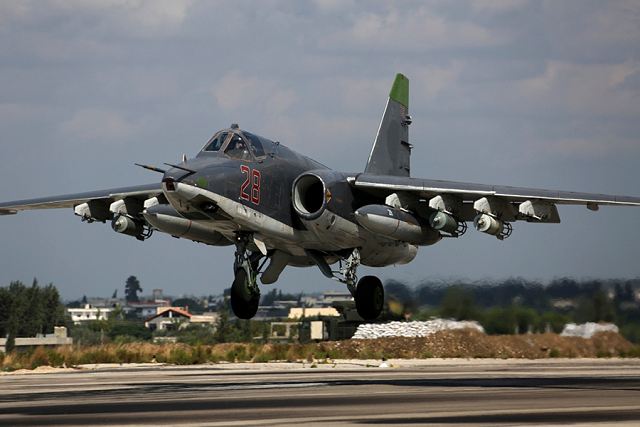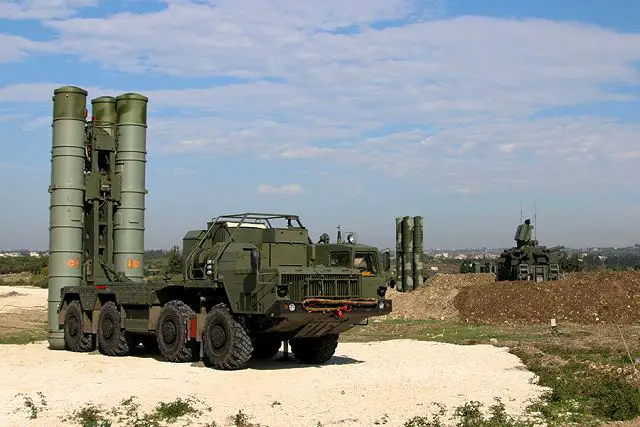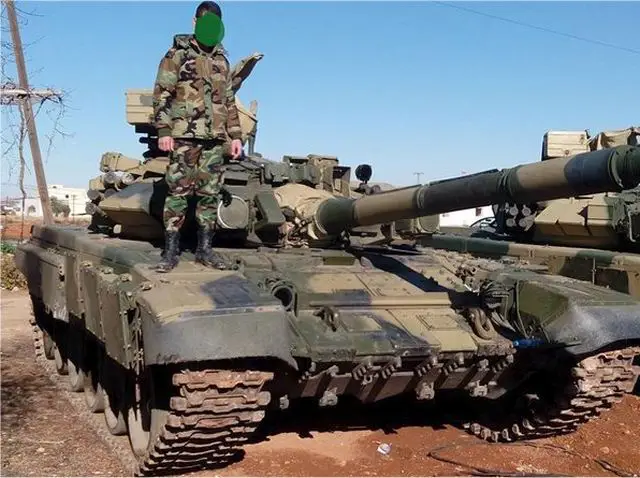Analysis of the Russian military operations in Syria after half year of presence in the country TASS 12803164
|
|
|||
|
The conflict in Syria
|
|||
|
|
|||
| Analysis of the Russian military operations in Syria after half year of presence in the country. | |||
|
Five and a half months of air operation in Syria cost Russia over 33 billion rubles ($480 million). Kommersant daily notes that besides political dividends Moscow is hoping for a major payback as foreign demand for weapons and armaments used in Syrian combat conditions is likely to rise. Director General of Rostech State Corporation Sergei Chemezov shares the view. "Orders of weapons always increase as the situation in the world aggravates," he said. It is now much easier to sell all hardware that flew and fired in Syria as there is no better marketing than combat activities.
|
|||
|
|
|||
 Russia Air Force Su-25SM take off from the Hmeymim airbase in Syria Russia Air Force Su-25SM take off from the Hmeymim airbase in Syria |
|||
|
|
|||
|
In half a year the Russian military actually turned Syria into a test range. Initially they used mostly well-known aircraft like modernized Su-24M bombers and attack Su-25SM jets but later engaged Su-34 bombers, Su-30SM fighters and finally the latest Su-35S.
Helicopters Mi-8P, Mi-24, Mi-35M, Mi-28N and Ka-52 were also deployed at Hmeymim airbase which was reliably protected by a ring of anti-aircraft missile and cannon complexes Pantsir-S1, as well as by air defense Buk-M2 and S-400 Triumph systems. Ground hardware in Syria included T-90 tanks and BTR-82A armored personnel carriers. Air bombs comprised not only old FAB-250 and OFAB-500 but also modern KAB-500S and air-based cruise missiles X-101 and X-555. The latter are intended to destroy powerful air defenses of the adversary however ISIS did not have them. Strikes by Caliber-NK cruise missiles from the Mediterranean and Caspian Seas deserve specific attention as 48 launches showed the excellent technical capabilities of the weapon. At present potential foreign buyers are eyeing tested weapons which had been either bought by another country or used by the Russian military. "In Syria we killed two birds with one stone. On the one hand, we demonstrated combat capabilities of our armaments and drew the attention of customers to them, and on the other hand, we trained over a half of available pilots in combat conditions," a source in the defense ministry said. The Russian military in Syria were accompanied by arms producers. Although the Russian armed forces already have the weapons the military decided to have experts at hand to be on the safe side. In some cases it was easier for them to prepare hardware and equipment for assigned missions. |
|||
|
|
|||
 Russian S-400 TEL air defense missile systems provides protection at the Hmeymim airbase in Syria Russian S-400 TEL air defense missile systems provides protection at the Hmeymim airbase in Syria |
|||
|
|
|||
|
Half a year of the air operation cost the military 33 billion rubles. The money was appropriated in the defense budget for exercises and military training but was used for a real war. The amount comprises all logistical and material costs. Kommersant daily estimates another 10 billion rubles may be necessary to replenish munitions stock and service the aircraft which in half a year flew over 9 thousand hours. Such intensity could not but affect the life cycle of Su-24M and Su-25SM which already have been several times modernized and repaired.
However the costs look small on the background of expected dividends. Since the beginning of the Syrian campaign the Russian Federal Service for Military-Technical Cooperation has received a number of requests from countries eyeing Russian military hardware and mostly willing to acquire combat aircraft. For example, in December 2015 Algeria requested 12 Su-32 bombers (export designation Su-34). Director of the Chkalov aircraft enterprise in Novosibirsk Sergei Smirnov said talks dragged for some eight years. However successful performance of the bomber in Syria provided a new impulse to negotiations. The first wing of Su-32 will cost Algerian military not less than 500-600 million dollars. An option for another 6-12 aircraft is not excluded. Algeria has also requested one Su-35S for tests at the Tamanrasset range to check the piloting characteristics of the aircraft, its radar and weapons capabilities. Algerian pilots were satisfied with the tests and now talks on the acquisition of at least ten fighters are expected. Kommersant daily estimated the potential deal at 850-900 million dollars. This year talks will continue with Algeria on two airlifters Il-76MD-90A (in case the contract is signed Algeria will receive them in 2017). Another achievement with Algeria is the delivery of 40 Mi-28NE combat helicopters. The first batch is ready for shipment. The role of the Syrian operation in promoting the craft is not that significant as Iraq had already acquired the helicopters to fight ISIS. Anyway, experts estimate the Algerian contract for Mi-28NE helicopters at 600-700 million dollars. |
|||
|
|
|||
 A Russian Air Force Su-35 fighter lands on the Hmeymim airbase in Syria A Russian Air Force Su-35 fighter lands on the Hmeymim airbase in Syria |
|||
|
|
|||
|
Interest in Su-35 fighters has been also displayed by Indonesia, Vietnam and Pakistan. Each of them has already operated Soviet and Russian-made jets but they want to radically modernize the air fleet.
Indonesia and Vietnam want to add Su-35 to previously acquired Su-30 MK2. Jakarta is said to want ten aircraft while Hanoi eyes a wing. In both cases the contracts will exceed one billion dollars. Experts say the Indonesian military may request a loan for the purchase. The situation is complicated with Pakistan. Besides a difficult economic situation the potential deal is impeded by India-related geopolitical aspects. New Delhi negatively reacted to the acquisition by Islamabad of four Mi-35M. President Vladimir Putin had to personally explain to Prime Minister Narendra Modi the jets will be used only to fight ISIS. Even in the best case the Pakistani military can afford not more than six fighters but even this deal is estimated at 500 million dollars. There is also interest in Ka-52 Alligator helicopters. Rosoboronexport arms trader signed a contract with Egypt for 46 aircraft and the delivery is to begin in 2017. Engagement of the helicopters in Syria is likely to lure new customers mostly in the Middle East. The T-90 tanks were deployed in Syria to protect Hmeymim airbase and to support the offensive by government troops of President Bashar al-Assad on ISIS positions. A video was posted in Internet showing a strike at the Russian tank by US anti-tank TOW complex. The armor of T-90 resisted the hit. The success will be now used in talks with potential clients, a top manager of a defense enterprise said. The clients include Iraq, Iran, Gulf countries, as well as CIS member-states. The Almaz-Antei Company is currently participating in DefExpo-2016 where it showcases mockups of integrated missile systems Caliber-PLE and Caliber-NKE. Although anti-aircraft complexes were used in Syria to detect rather than destroy targets the demand for them has also increased. The deployment of S-400 in Syria triggered a major interest in Saudi Arabia and intensified talks with India. In each case the potential deal may see the purchase of four to six S-400 batteries which cost some 2-3 billion dollars depending on the number of launchers. Experts estimate the marketing effect of the Syrian campaign can result in contracts worth close to 6-7 billion dollars (420-490 billion rubles by the current exchange rate). Interest in Russian military hardware has truly increased however no final contracts have been signed so far. It is clear various obstacles may impede the deals: technical (enterprises are busy with other orders), financial (customer lacks money), force majeure (revolution or military conflict with the supplier). |
|||
|
|
|||
 Russian T-90 main battle tank in Syria Russian T-90 main battle tank in Syria |
|||
|
|
|||
| © Copyright 2016 TASS. All rights reserved. This material may not be published, broadcast, rewritten or redistributed. | |||




























